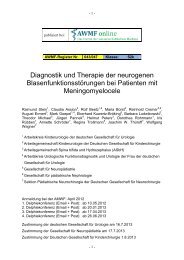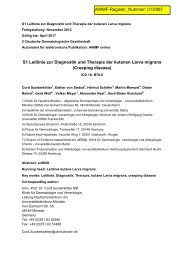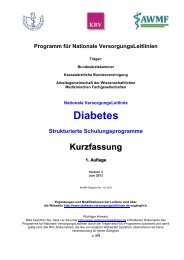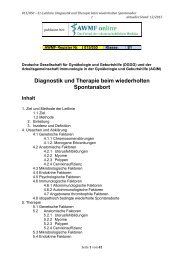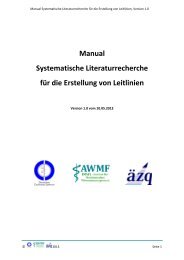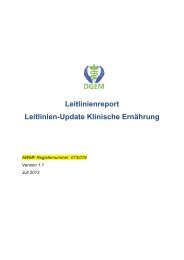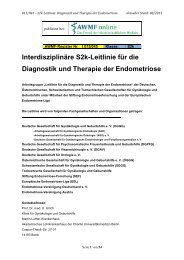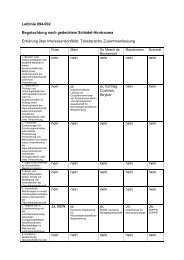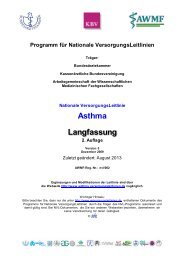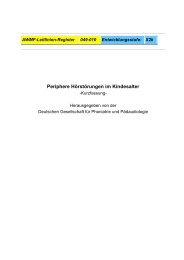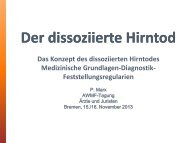012-010 S1 Bakterielle Gelenkinfektionen 05-2008 05-2013 - AWMF
012-010 S1 Bakterielle Gelenkinfektionen 05-2008 05-2013 - AWMF
012-010 S1 Bakterielle Gelenkinfektionen 05-2008 05-2013 - AWMF
Erfolgreiche ePaper selbst erstellen
Machen Sie aus Ihren PDF Publikationen ein blätterbares Flipbook mit unserer einzigartigen Google optimierten e-Paper Software.
14. Gächter A (1988) Die Bedeutung der Arthroskopie beim Pyarthros. Unfallheilkunde 200:132-136<br />
15. Gächter A (1994) Gelenkinfekt - Arthroskopische Spülungsbehandlung - Hints und Tricks.<br />
Arthroskopie 7:98-101<br />
16. Garcia-De La Torre I (2003) Advances in the management of septic arthritis. Rheum Dis Clin North<br />
Am 29:61-75<br />
17. Goldenberg DL and Reed JI (1985) Bacterial arthritis. N Engl J Med. 312:764-771<br />
18. Hamed KA, Tam JY and Prober CG (1996) Pharmacokinetic optimisation of the treatment of septic<br />
arthritis. Clin Pharmacokinet. 31:156-163<br />
19. Ho G Jr (2001) Bacterial arthritis. Curr Opin Rheumatol. 13(4)::310-314<br />
20. Johnson JS and Freemont AJ (2001) A 10 year retrospective comparison of the diagnostic usefulness<br />
of synovial fluid and synovial biopsy examination. J Clin Pathol 54:6<strong>05</strong>-607<br />
21. Kuner EH, Thurck HU and von der Lippe I (1987) Zur Diagnostik und Therapie der akuten<br />
Kniegelenkinfektion. Unfallchirurgie 13:249-254<br />
22. Masi AT and Eisenstein BI (1981) Disseminated gonococcal infection (DGI) and gonococcal arthritis<br />
(GCA): II. Clinical manifestations, diagnosis, complications, treatment, and prevention. Semin Arthritis<br />
Rheum. 10:173-197<br />
23. Nierman E and Zakrzewski K (1999) Recognition and management of preoperative risk. Rheum Dis<br />
Clin North Am. 25:585-622<br />
24. Dt. Ges. f. Orthopädie und Traumatologie + Berufsverb. d. Ärzte f. Orthopädie (ed) (2002) Leitlinien<br />
der Orthopädie, 2 edn. Dt. Ärzte-Verlag, Köln<br />
25. Pozzilli P and Leslie RD (1994) Infections and diabetes: mechanisms and prospects for prevention.<br />
Diabet Med. 11:935-941<br />
26. Sattar MA, Barrett SP and Cawley MI (1983) Concentrations of some antibiotics in synovial fluid after<br />
oral administration, with special reference to antistaphylococcal activity. Ann Rheum Dis. 42:67-74<br />
27. Schubert S and Heesemann J (1995) [Infections in diabetes mellitus]. Immun Infekt. 23:200-204<br />
28. Simank HG, Wadi B and Bernd L (2004) Gelenkempyeme. Orthopäde 33:327-331<br />
29. Smith JW and Piercy EA (1995) Infectious arthritis. Clin Infect Dis 20:225-230<br />
30. Somekh E, Heifetz L, Dan M, Poch F, Hafeli H and Tanai A (1996) Penetration and bactericidal<br />
activity of cefixime in synovial fluid. Antimicrob Agents Chemother. 40:1198-1200<br />
31. Stutz G and Gachter A (2001) Diagnostik und stadiengerechte Therapie von Gelenkinfekten.<br />
Unfallchirurg 104:682-686<br />
32. Stutz G, Kuster MS, Kleinstuck F and Gachter A (2000) Arthroscopic management of septic arthritis:<br />
stages of infection and results. Knee Surg Sports Traumatol Arthrosc. 8:270-274<br />
33. Wirtz DC, Marth M, Miltner O, Schneider U and Zilkens KW (2001) Septic arthritis of the knee in<br />
adults: treatment by arthroscopy or arthrotomy. Int Orthop 25:239-241<br />
34. Wollenhaupt J and Zeidler H (1998) Undifferentiated arthritis and reactive arthritis. Curr Opin<br />
Rheumatol 10:306-313<br />
35. Zifko B (1984) Die funktionelle Knieempyembehandlung. Unfallheilkunde 87:479-487<br />
Verfahren zur Konsensbildung:<br />
Leitlinienkommission<br />
der Deutschen Gesellschaft für Unfallchirurgie e.V. (DGU) in Zusammenarbeit mit der Österreichischen<br />
Gesellschaft für Unfallchirurgie (ÖGU):<br />
Prof. Dr. Klaus Michael Stürmer, Göttingen (Leiter);<br />
Prof. Dr. Felix Bonnaire, Freiburg (stellv. Leiter);<br />
Prof. Dr. Walter Braun, Augsburg;<br />
Prof. Dr. Klaus Dresing, Göttingen;<br />
Doz. Dr. Heinz Kuderna, Wien (ÖGU);<br />
Dr. Rainer Kübke, Berlin;<br />
Prof. Dr. Norbert M. Meenen, Hamburg;<br />
Prof. Dr. Jürgen Müller-Färber, Heidenheim;<br />
Dr. Martin Leixnering, Wien (ÖGU);<br />
Priv.-Doz. Dr. Wolfgang Linhart, Düsseldorf;<br />
Priv.-Doz. Dr. Gerhard Schmidmaier, Berlin;<br />
Prof. Dr. Hartmut Siebert, Schwäbisch-Hall;<br />
Prof. Dr. Ernst Günter Suren, Heilbronn;<br />
Dr. Bernd Wittner, Stuttgart<br />
Federführende Autoren:<br />
F. Bonnaire, Freiburg und<br />
A. Weber, Dresden<br />
15 19.10.2<strong>010</strong> 17:46<br />
Die "Leitlinien" der Wissenschaftlichen Medizinischen Fachgesellschaften sind systematisch entwickelte<br />
Hilfen für Ärzte zur Entscheidungsfindung in spezifischen Situationen. Sie beruhen auf aktuellen wissenschaftlichen<br />
Erkenntnissen und in der Praxis bewährten Verfahren und sorgen für mehr Sicherheit in der Medizin, sollten aber auch<br />
ökonomische Aspekte berücksichtigen. Die "Leitlinien" sind für Ärzte rechtlich nicht bindend und haben daher weder<br />
haftungsbegründende noch haftungsbefreiende Wirkung.<br />
Die <strong>AWMF</strong> erfasst und publiziert die Leitlinien der Fachgesellschaften mit größtmöglicher Sorgfalt - dennoch kann die<br />
<strong>AWMF</strong> für die Richtigkeit - insbesondere von Dosierungsangaben - keine Verantwortung übernehmen.




